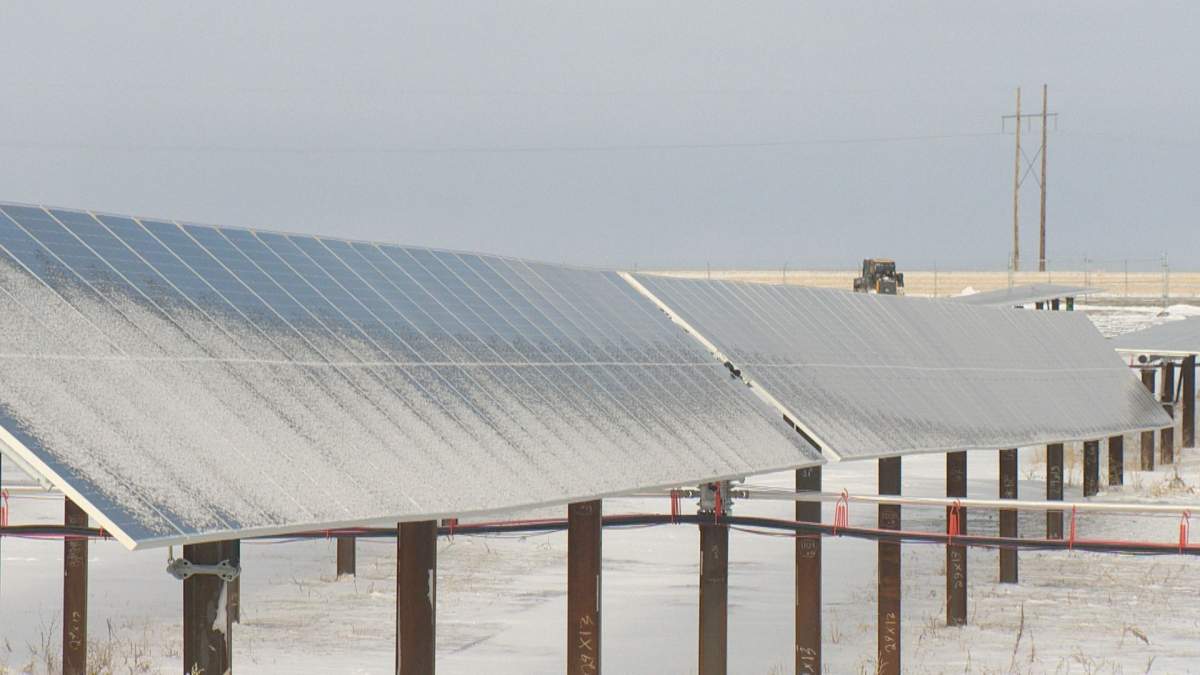One of the largest solar power plants ever built in Saskatchewan is now online and it sits just outside of Regina on Cowessess First Nation land.

The 10-megawatt Awasis Solar facility is owned by Cowesses First Nation and Elemental Energy. Cowessess First Nation owns 95 per cent of the facility and Elemental Energy owns the remaining five per cent.
The power generated by the plant will be sold to SaskPower for the next 20 years as part of a power purchase agreement.
The newly built solar power facility will be generating revenue for Cowesses First Nation. Cowessess First Nation Chief Cadmus Delorme says it will bring his community economic prosperity.
“We will use the revenue, the profit of this project to make sure we reinvest in our renewable energy projects,” Chief Delorme said at an event held at the facility.
“Some of the profit made here will lead to us having more investment in not only owning the project, having it on our line, but having equity as well. Secondly, some of the profit made will go to underfunded areas — language, family, culture, off and on reserves.”
The Awasis solar plant can power as many as 10,000 homes in optimal conditions.

Get breaking National news
The panels are bifacial, which allows them to capture the sunlight reflected from the snow, and they also move along with the sun throughout the day to optimize the amount of energy collected.
“SaskPower is transforming the way it powers the province, and projects like Awasis will be essential to reach net-zero greenhouse gas emissions,” said Don Morgan, minister responsible for SaskPower.
Jonathan Wilkinson, minister of natural resources, also attended the celebration event and said that as Indigenous communities are experiencing the impacts of climate change firsthand, taking action in fighting climate change and building an economy that is strong and prosperous is a great initiative.
“We must collectively work to figure out how we lower emissions while growing the economy and providing our children with better economic opportunities than their parents and their grandparents had,” he said.
- US forces stop 2nd oil tanker off Venezuela coast as Trump follows promise to seize tankers
- Flu hospitalizations rise sharply as H3N2 spreads across Canada
- Tax season is still months away. Doing 3 things now could help you later
- Paraplegic engineer becomes the first wheelchair user to blast into space
Wilkinson added that the project is expected to reduce 14,000 tons of greenhouse gas emissions in the first year of operations and about 350,000 tons of emissions over the 35-year life of the project. That is the equivalent of taking 70,000 gas-powered cars off the road every year.
“SaskPower is well on track to reduce its emissions to 50 per cent below 2005 levels by 2030, and adding non-emitting sources like wind and solar is an important part of our plans. We look forward to continued collaboration with First Nations and industry as we work to achieve our targets,” Rupen Pandya, SaskPower president and CEO, said.
Chief Delorme said the $200-million project is a form of reconciliation and a stepping stone to the Truth and Reconciliation Commission’s calls to action.
“Number 92 (economic profit) of truth and reconciliation calls to action is exactly why we’re all here today. We don’t have the equity for some projects like this. It’s not that we are poor or anything like it, just that any dollars we make goes to unfunded areas in housing, language, families.
“This is precisely the type of project we need to see more of from coast to coast to coast.”
Chief Delorme said he hopes projects like these inspire more Indigenous youth to get into programs like science and engineering.
“Our kids get to see that every day when they’re on the bus, which will encourage them to go back to school in science and engineering.”









Comments